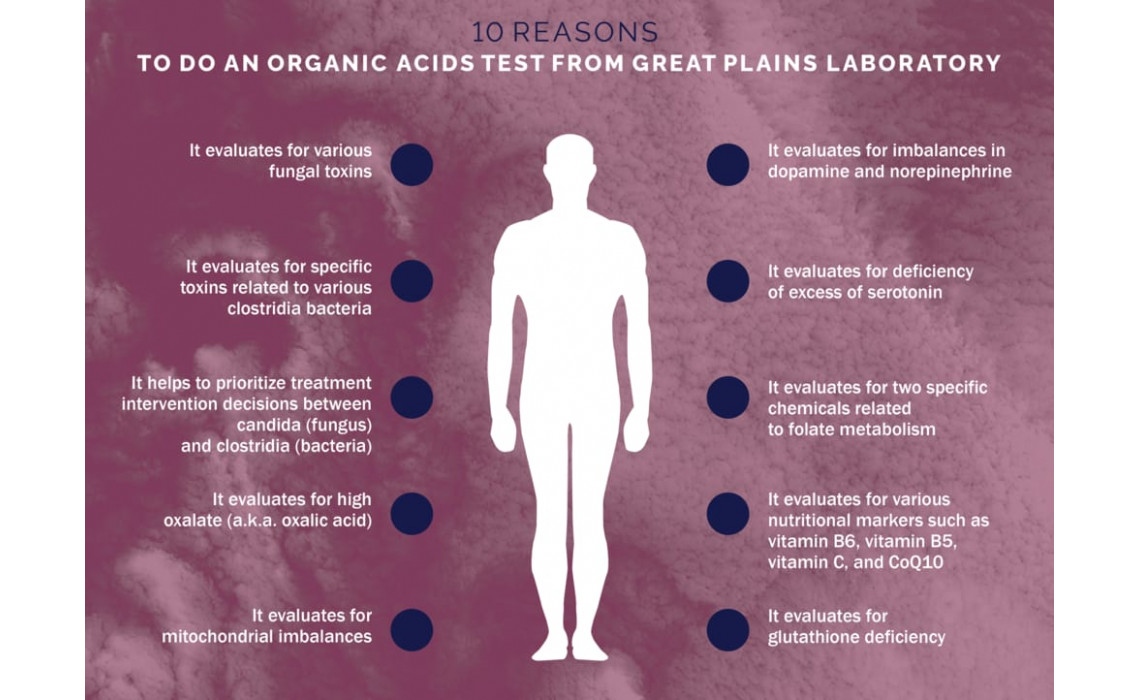Top 10 reason to do an Organic Acids Test - Great Plains Laboratory
Organic acids (OAs) are compounds that have acidic properties, and many are normal byproducts of biochemical, a.k.a. metabolites. However, there are certain compounds that provide clues regarding metabolic disorders, including mitochondrial dysfunction, and potential toxin exposures which can negatively impact health. Certain elevated amino acid metabolites can even be linked to rare genetic diseases called inborn errors of metabolism. These markers found on page five of the Organic Acids Test (OAT) are fortunately rare.
Other organic acid compounds are seen elevated with overgrowth of opportunistic and pathogenic digestive bacteria, as well as yeast and other fungi. Certain microorganism-produced compounds, e.g., HPHPA, can alter neurochemical activity, affecting the brain and nervous system, which leads to behavioral, cognitive and various physical health problems.
The OAT from Great Plains Laboratory evaluates over 70 urinary metabolites that can be useful for discovering underlying causes of chronic illness. Treatment(s) based on OAT assessments can often lead to improved energy, sleep, and mental health conditions, as well as reduced attention and concentration problems, chronic pain, and digestive issues. The OAT is more than just a single test. Instead, it should be viewed as a comprehensive profile that combines different categories that when organized together and understood from a fundamental standpoint is a game changer in practice or for any individual seeking deeper answers to often overlooked health problems.
The following is a list of ten descriptions for why the Organic Acids Test from Great Plains Laboratory is worth doing and learning more about:

The OAT evaluates for various fungal toxins, including specific markers for candida, as well as other fungus such as mold and yeast. Many individuals rely on stool testing for candidiasis diagnosis. However, a stool test is often negative for candida overgrowth detection, while the OAT often detects the presence of candida and yeast toxins (authors experience). The OAT is overall more sensitive for candida analysis because it is detecting chemical production within the digestive system that is reflective of these organism’s metabolic activity, and tissue invasion along the mucosal lining of the gut. The organic acid arabinose, often elevated on the OAT, is linked to this process of mucosal invasion. Some of candida toxins can create problems with brain function including memory, attention, and focus.

The OAT evaluates for specific toxins related to various clostridia bacteria. Clostridia bacteria such as Clostridia difficile (C. diff.) can lead to digestive problems and poor health (1). For example, certain strains of C. diff. produce virulence factors which cause inflammation, bleeding, and diarrhea within the digestive system. However, there are other clostridia toxins that work outside the digestive system. The main toxins evaluated on the OAT linked to different strains of clostridia are HPHPA and 4-cresol (2). Both HPHPA and 4-cresol can inhibit a dopamine converting enzyme leading to excess dopamine in the brain and nervous system (3).
High dopamine can form toxic compounds that adversely affect brain cells. Long-standing elevation of these dopamine related compounds such as DOPAC (and dopamine-o-quinone, a compound not measured on the OAT) are known to trigger free radical damage within the brain. The elevation of the neurotransmitter dopamine can also cause mood instability, and other cognitive problems. In severe cases, the presence of these clostridia toxins can trigger aggressive and self-injury behavior from high amounts of dopamine. This is a common scenario in special needs individuals such as those with autism. Evaluating for clostridia organic acid toxins is essential for anyone struggling with a developmental disorder, mental health problems, and neurological diseases.

The information from the OAT helps to prioritize treatment intervention decisions, along with symptoms and clinical history, between candida (fungus) and clostridia (bacteria). Treating for candida alone when clostridia bacteria toxins of HPHPA and 4-cresol are present may lead to significant problems aggravating the digestive system, but also leading to adverse changes in neurochemicals affecting behaviors, cognitive abilities, mood, and mental stability.

The OAT evaluates for high oxalate (a.k.a. oxalic acid). Oxalate is a compound found in many foods such as nuts (e.g., almonds), fruit (e.g., berries) and certain vegetables (e.g., spinach). Oxalate can also be produced by candida overgrowth, aspergillus mold, as well as certain metabolic imbalances linked to deficiency in oxalate metabolizing enzymes. High oxalate is often associated with joint and muscle pain but can lead to bladder and bowel discomfort as well. Severe cases of oxalate accumulation can cause kidney stones. Oxalate can trap heavy metals such as mercury, lead, and arsenic in the body and lead to mineral imbalances.

The OAT evaluates for mitochondrial imbalances. The mitochondria are the energy factories of our cells producing large amounts of adenosine triphosphate (ATP). ATP acts as energy currency for our body. Mitochondria are often stressed because of toxins from candida, bacteria, oxalate, heavy metals, and environmental chemicals. Mitochondrial dysfunction is common in many chronic health disorders.

The OAT evaluates for imbalances in dopamine and norepinephrine (4). The relationship between these two important brain chemicals is critical for attention, focusing, mood, calmness, and other functions of the nervous system.

The OAT evaluates for deficiency of excess of serotonin, an important brain chemical for mood, fine and gross motor skills, calmness, and sleep. There are other markers evaluated on the OAT that can indicate toxic stress in the brain and nervous system. One of these potentially toxic compounds is called quinolinic acid (QA). Elevated QA can be toxic in the brain triggering increase receptor activity that allows for increase influx of calcium into a brain cell. This mechanism can lead to a host of cell problems causing or contributing to brain cell death and destruction. For these reasons, it is beneficial to perform an OAT before implementing high dose amino acid L-tryptophan supplementation which is often used to assist with sleep or some mental health disorders.

The OAT evaluates for two specific chemicals related to folate metabolism. Folate is linked to the methylation cycle that supports the inner workings of the cells related to DNA function and metabolism. Poor folate metabolism can lead to cognitive problems.

The OAT evaluates for various nutritional markers such as vitamin B6, vitamin B5, vitamin C, CoQ10, as well as N-Acetylcysteine (NAC). NAC is necessary as a precursor for the antioxidant glutathione.

The OAT evaluates for glutathione deficiency. Glutathione is a powerful antioxidant in our cells and protects against toxicity. The lack of glutathione leads to oxidative stress within the brain and nervous system which causes poor attention, focusing, and overall cognitive challenges. Glutathione deficiency can also compromise immune system health. Glutathione is a necessary compound involved liver detoxification of chemicals.



